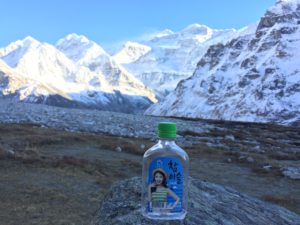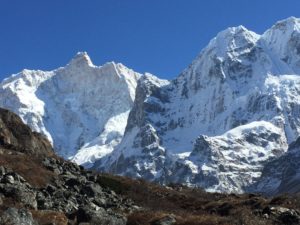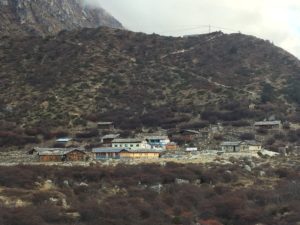Kanchenjunga Base Camp Trek is an exotic trekking trip in the north-eastern part of Nepal, offering you with dramatic view of Kanchenjunga summits and great cultural insights.
Mt. Kanchenjunga, the third highest peak in the world (8,586) has 5 peaks and regarded as the queen of mountains. Kanchenjunga in Tibetan dialects refers to “Five Great Treasure in the Snow” which symbolizes its 5 summits – as gold, silver, precious stones, grains and Holy Scriptures.
Trekking to Kanchenjunga is restricted for outsiders; you need a local guide and at least 2 trekkers to purchase the required permits.
Kanchenjunga trek is least popular compared to other trekking routes like Everest Base Camp Trek or Annapurna Base Camp; so the impact of mass tourism is yet flourish the region.
About Kanchenjunga

Kanchenjunga, also known as Kumbhkaran Lungur, is the third highest mountain in the word with an elevation of 28,169ft (8,586m). It is located at the eastern Himalayan range; bordering to Sikkim state and Tibet, autonomous of China.
Kanchenjunga was considered as the highest mountain in the mountain in the world until 1852; it was before the discovery of Mt. Everest. After the Great Trigonometrical Survey of India discovered and calculated the height of Everest (known as Peak XV at the time) – Mt. Everest got its fame.
Located at Latitude 270 42’ 9’’ and Longitude 880 9’ 1’’, Kanchenjunga is one of least explored Himalayas in the world. After several unsuccessful attempts, Kanchenjunga was fist summited in 1955 by Joe Brown and George Band – a British expedition lead by Charles Evans. Wanda Rutkiewicz, the greatest women climber ever, died on her way to Kanchenjunga on May 12 1992.
Kanchenjunga region is protected by Kanchenjunga Conservation Area in the Himalayas of eastern Nepal. The region is spread over 2,035 km square (786 Sqmi) and consist two peaks of Kanchenjunga. The conservation area is developed by WWF Nepal in partnership with the International Center for Integrated Mountain Developed.
Kanchenjunga Conservation Area is filled with cultivated lands, forests, pastures, rivers, high altitude lakes and glaciers. Different species of mammals thrives here which includes the rare snow leopard, Asian Black Bear and Red Panda. Bird species include – golden-breasted fulvetta, snow cock, blood pheasant and red billed chough.
Some profile Peaks in Kanchenjunga Range
Main Kanchenjunga Peak: 8,586m/28,169ft
Kanchenjunga West Peak: (Yalung Kang): 8,505m/27,904ft
Central Kanchenjunga Peak: 8,482m/27,828ft
South Kanchenjunga : 8,494m/27,867ft
Kangbachen: 7,903m/25,928ft
How to Reach Kanchenjunga Base Camp?

Located at far-eastern Nepal, Kanchenjunga region is accessible via road and airways. The starting point is at Taplejung.
By Roadways:
Trekkers can reach Taplejung within 24 hours from Kathmandu using shared or private jeep. You can fly to Biratnagar or Bhadrapur and take a road drive to Taplejung (which takes around 8 – 9 hour).
By Airways:
The nearest airport is the Suketar Airport located in Taplejung which takes around 1 hour.
Best Time to Go for Kanchenjunga Base Camp Trek
Mid-March – June end and Mid-September to Mid – November are considered as the best time of the year for Kanchenjunga Base Camp Trek.
Winter (Late December – Early March)
Winter is extremely cold in Kanchenjunga region. Sela Le pass is not possible to cross due to snows and slippery ice.
If you are trekking Kanchenjunga in winter, we suggest you to check the availability of accommodation in Lhonak and Khambachen, you can check it in Ghunsa. You can check the availability of Cheram and Ramche in Yamphuding.
Level of Difficulty
Winter brings cold weather at alpine altitude and the trails are unsually slipper and unfavorable for trekking. We suggest you to bring a winter shoes, crampons and gaiters to tackle the fresh snow.
Trekkers must be equipped with warm and proper clothes to cope freezing temperature. You will hardly meet trekkers in winter. Moreover most of teahouse remains closed but you can request them to open for you. Winter is best time for those trekkers who wants to discover the Kanchenjunga at its best.
Monsoon (June – Mid-September)
Monsoon is not favorable season to trek Nepal.
Level of Difficulty
Beside the potential threat of landslide and flood, the annoying leeches challenges you throughout the entire trail. The grooving cloud over the mountain obscures the view most of the time. The route of Kambachen, Ghunsa, Torongding and Yamphuding needs to be updated frequently. Make the local inquiries before heading!!
Autumn (Late September – Mid-December)
Autumn is one of the best trekking season because the weather is stable, temperature’s moderate and sky tends to be clear with magnificent views.
Difficulty
As it is the high season to visit Kanchenjunga, anyone with high fitness level and string determination can enjoy the trek.
Spring (March – Late May)
Spring is another peak season to go for trekking in Kanchenjunga Base Camp, as temperature and climate tends to be more stables with mesmerizing views.
Difficulty
Trails are more crowded and the skies can be hazy sometimes. But it does not happen often.
Highlights of Kanchenjunga Circuit Trek
- Mount Kanchenjunga (8,586m) – the third highest peak in the world
- Ethnic culture of Limbo and Tamang Community
- Remote, isolated and intact natural and cultural sites
- Diverse landscapes from tropical forest – alpine and snowy barren landscapes
- Kanchenjunga glaciers and others
- Torrent River and spectacular waterfalls
Permits for Kanchenjunga Base Camp Trek
You need to obtain special trekking permit to visit the area available in Nepal Tourism Board.
Trekkers also need to purchase a Kanchenjunga Conservation Area Permit (KCAP).
Likewise, you need to hold a valid passport and a visa to enter Nepal via air or a roadway.
Rules to purchase Kanchenjunga Base Camp Trek Permit
- Travelers must be in a group of at least 2 people
- Participants must accompany a government licensed guide and a porter
- Also they must hire a local trekking agency to purchase a trekking permit
Kanchenjunga Base Camp Trek Permit Cost
Restricted Area Trekking Permit: USD 10 per person per week (or equivalent foreign currency)
The village of Olangchukgola, Lelep, Yamphudin and Papung are restricted area in Kanchenjunga region.
Kanchenjunaga Conservation Area Permit Cost: NRS 2,000 per person or equivalent foreign currency.
Cultures and Lifestyle in Kanchenjunga Base Camp Trek

The region is home to diverse culture and tradition. KBC trek is three weeks+ teahouse trek with variety of ethnic groups.
Trekkers will encounter dense Hindu community in lower reaches. Here you will get the knowledge of traditional farming and visit religious sites.
While, you will discover Tibetan lifestyle and food at higher altitude. Buddhist settlement dominates the region with very few Hindu community. Likewise the region is full of ancient monuments such as stupas, Bihar and monasteries. The main occupation of locals are tourism, animal husbandry and agriculture.
Altitude Sickness during Kanchenjunga Base Camp Trek
Altitude Sickness, also known as Acute Mountain Sickness (AMS), is negative health effect of thin atmospheric level in high altitude; with less amount of oxygen. It brings a collection of non-specific symptoms, acquired at high altitude or in low air pressure.
Although, you might encounter minor symptoms like breathlessness at an altitude of 1,500, (5,000 ft), AMS typically occurs above 2,400m (8,000ft).
Acute Mountain Sickness can go worse to high altitude pulmonary edema (HAPE) or high altitude cerebral edema (HACE), both of which are fatal and even led to death. This can only be cure by immediate descent to lower altitude or oxygen administration.
Acute Mountain Sickness (AMS) is prone in Kanchenjunga region trek as there is sudden gain in altitude. Proper acclimatization and hydration is must. Walk on a gradual pace and take rest if needed before stepping your foot forward. An experienced guide knows exactly when your needs to acclimatization, so better accompany a professional Kanchenjunga trekking guide. Also listen to your guide and follow his footsteps strictly.
Symptoms:
- Difficulty sleeping
- Dizziness or light-headedness
- Fatigue
- Headache
- Loss of appetite
- Nausea
- Difficulty sleeping
- Rapid pulse (heart rate)
- Shortness of breath with exertion
Kanchenjunga Base Camp Trek Difficulty
Kanchenjunga Trek is one of the challenging high altitude treks in Nepal. Trekkers have to cross 5,000m+ high passes and walk along the remote high altitude trail for several days. Altitude is major problem in Kanchenjunga Circuit trail. Tourism infrastructure is almost in zero condition above in high altitude. The misleading trail often covered with snows makes it very difficult to point out the right trail.
How much the does the Kanchenjunga Base Camp Trek Cost?
Trekking agency charges anywhere between USD 2,000 – USD 3,500.
The Kanchenjunga trek cost must include: transportation, accommodation, food, guide and porter. It also includes the cost of special permit and KCAP.
Essential Checklist of Kanchenjunga Base Camp Trek
Because of its isolation and remoteness, you might not find even a basic things for your personal comfort. Here are the list of few things you need to carry for your comfort.
Clothes and Footwear
Depending on the time, you need to pack your clothing. The high altitude in Nepal usually remains below freezing level and invites a risk of altitude sickness.
- Trekking Boots
- Warm Slippers
- Few pairs of inner wears
- Fleece Jacket
- Waterproof Jacket
- Trousers and T-shirts
- Sleeping Bag and Tent
- Trekking Poles
- Warm Gloves
- Sanitary Napkins
- Sunglasses, torchlight and water bottle
- Toiletries
- First Aid Kit
- Altitude sickness – Diamox and medicines – Headache, Stomachache
- Medial kit
These checklist will help with any high altitude trekking adventure in Nepal – Dhaulagiri Circuit Trek, Manaslu Circuit Trek, Upper Dolpo Trek and Tsum Valley Trek.
FAQs of Kanchenjunga Base Camp Trek
Is it safe to trek Kanchenjunga after earthquake?
The eastern part of Nepal got less impact compared to the western and mid regions. There are no official reports of death in Kanchenjunga trekking trail. All trails are safe and teahouses are strong enough to provide you safe accommodation.
Moreover, there are landslides, flood and avalanches recorded last few years.
We assure you that Kanchenjunga Base Camp Trek is 100% safe to travel despite devastating earthquake in Nepal.
Who is Kanchenjunga Base Camp Trek for?
Kanchenjunga trekking is for those who wish to enjoy solitude trekking in untouched and pristine nature of Himalayas. If you are highly fit and want to push your limit, then this trek is for you.
Is Independent trekking allowed for Kanchenjunga Base Camp Trek?
Kanchenjunga is restricted area for trekking; so you are not allowed a DIY adventure. Since the area is remote, you can encounter high risk in such a wild and uneven topography. So the Government of Nepal have made the rules of group trip (minimum) with at least 1 porter or a guide.
The trail goes through remote landscapes and the communication is very poor. You will rarely encounter a large group of people on the trial expecit in the loges. So it is not god to trek along in Kanchenjunga region.
What are accommodation and food like in Kanchenjunga Base Camp Trekking Trial?
Being an isolated and remote region, you will find very basic lodges on the trail (but improving). The lodges will provide basic facilities to rest after a tiresome day.
Don’t expect heater, attached bathroom, hot showers and quick room service in the middle of mountains.
But you will be provided with a warm blanket and comfortable pillows. You can bring sleeping bag with liner for comfortable night.
Daal Bhaat Tarkari (an authentic Nepali food) along with some common international cuisines are available in teahouse along the trail. Dhaal Bhaat Tarkari are staple food which are filling and full of good calories. It helps you regain your strength and pushes you beyond even without food for several hours. Good thing is that all the food are prepared from organic vegetables grown on the farmland right next to you. Pasta, Mo-Mo, Chaumin and Noodle Soup are some international cuisine available in the lodges.
You can bring your favorite snacks, chocolate bars and energy drinks.
How difficult is the Kanchenjunga Base Camp?
It is difficult in terms of trekking route but with less number of tourist, you can call it a wilderness trekking compared to other areas. The tourism infrastructures are very low, you need to carry all the personal necessities by yourself – making it one of remote treks in Nepal.
How fit do I need to be for Kanchenjunga Base Camp Trek?
Kanchenjunga Trek calls high level fitness, flexibility and strong determination . You will need to walk over the high pass (5,000+) and trek along the remote terrain for several days. Better get ready to take-on the challenge that the mountain throws.








